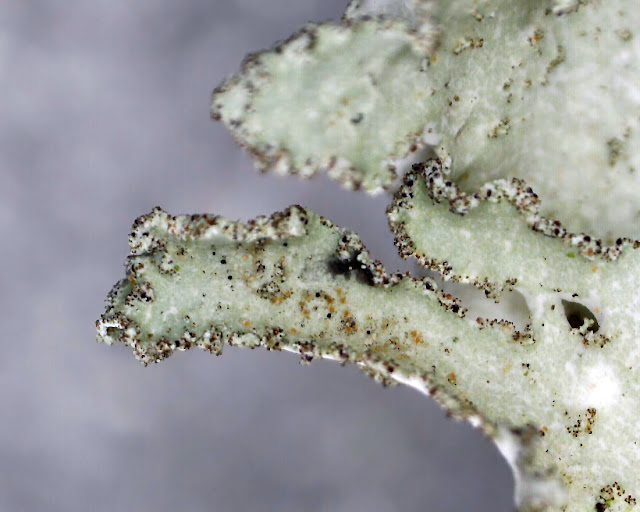Lichens are so confusing! If they would only grow in separate patches, like the rows of beans and carrots in a garden ... But no, they scramble themselves together, on top of, underneath, in the middle of each other.
Like yesterday's puzzle piece. Here it is, again.
 |
| Two lichens; identified as a Parmelia sp. and a Hypogymnia sp. |
This was a photo taken by my hobby microscope, looking at a twig I'd brought home from the woods.
 |
| My twiggy lichen "bouquet" |
 |
| Just the left-hand twig with its burden of 4 lichens. |
One of the lichens is a leafy species; this would be one of the Parmelia spp. The upper surface is pale greenish-grey, the lower surface, in part, black or dark brown. The edges of the lobes carry tiny soredia, reproductive bodies that look like black specks.
 |
| Curly edges of the lobes, with their soredia. |
 |
| More soredia. Many more. |
 |
| The underside of one lobe. |
The second lichen is a Hypogymnia spp., one of the bone lichens.
 |
| The tip of that same twig. |
Again, the upper surface is green, the bottom black. But these are long lobes, bone-shaped.
And here, you can see those black patches that are on the two lower layers of the first photo. The upper layer is clear on top, but on the underside it has these root-like structures, holdfasts, called rhizines, which identify this layer as a Parmelia.
Here, so you don't have to scroll back up, is that first photo:
 |
| Three layers. |
And thanks to the experts on Field Naturalists of Vancouver Island for their help in solving this mystery.
There were 4 lichens on these twigs. The other two, I'll leave for tomorrow.
~~~~~~~~~~~~~~~~~~~~~~~~~~~~~~~~~~~~
¡Los líquenes son tan complicados! Si crecieran por separados, algo así como las lechugas y las zanahorias en un jardín, ... pero, no; tienen que crecer todos amontonados, uno encima, abajo, adentro, en medio del otro.
Como los de la foto que subí ayer. Aquí la subo otra vez.
Fotos:
- Son dos líquenes, una Parmelia y una Hypogymnia. Esta fue una foto hecha por mi microscopio "hobby" viendo una ramita que me traje del bosque.
- Las dos ramitas en un recipiente.
- La ramita de la izquierda con su mezcla de 4 líquenes.
- Una de las ramitas es un liquen folioso, de las especies Parmelia. La superficie superior es de un verde grisáceo; la parte inferior tiene manchas café oscuros o negros. Y los bordes de los lóbulos llevan unas bolitas negras, cuerpos reproductivos llamados soredia.
- Otra foto con soredia.
- La parte inferior de un lóbulo.
- El segundo liquen es una Hypogymnia, uno de los llamados líquenes de hueso. Los lóbulos son largos, con forma de hueso.
- Esta foto muestra la punta de una rama, y se ven las manchitas negras que también se ven en los dos niveles de la foto primera.
- Que se repite aquí por conveniencia. Se ve que el liquen superior es sin manchas en la parte superior, pero debajo lleva estas estructuras parecidas a raices, "agarraderas", o rizinas, los cuales identifican este liquen como Parmelia.
Muchas gracias a las peritas del grupo Facebook Field Naturalists of Vancouver Island por su ayuda con la identificación.
Había 4 líquenes en esas ramitas. Dejo los otros dos para mañana.


Thank you.
ReplyDelete